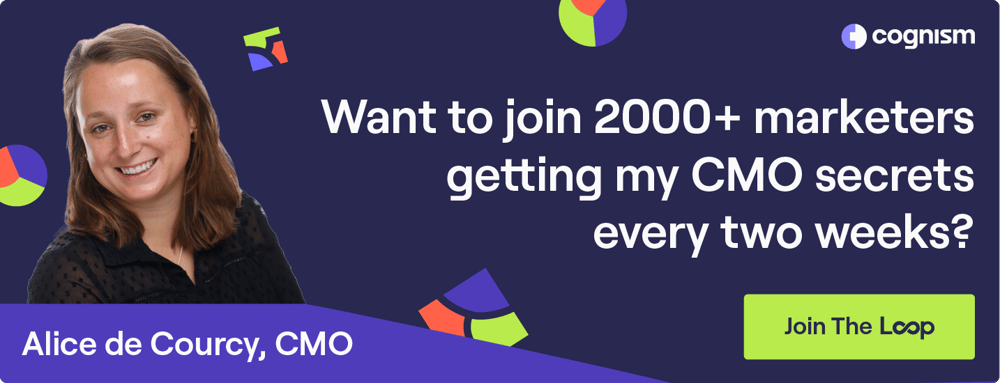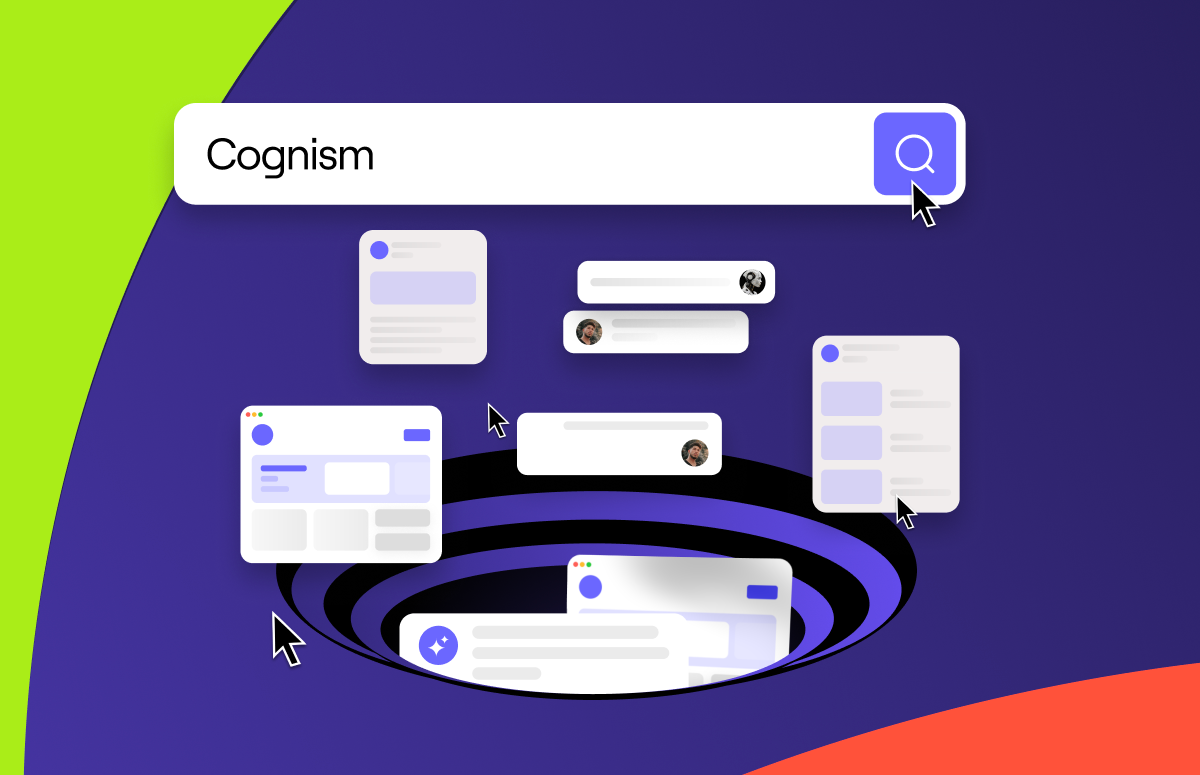B2B Influencers: How to Find and Work With Them
What's on this page:
Nowadays, it’s pretty easy to imagine a B2C influencer, right?
You might think of the ones you follow on social media who tell you about their latest clothing collaboration or what teeth-whitening products they use.
But what springs to mind when you think of a B2B influencer?
The picture is definitely less clear. But we reckon influencers can play a big role in B2B marketing. In fact, we have been using them to build our ‘media machine’.
Don’t worry; we’ll get into what we mean by this - and more! Keep reading to hear insights from Cognism’s VP of Marketing, Liam Bartholomew.
B2B influencers: who are they?
Our homemade definition of a B2B marketing influencer is:
‘An influential person who has a reputation as an expert in their field. They have curated an audience (followers!) that trust and respect them. And they create content that educates and entertains their audience.’
Some examples of B2B influencers that you might already know include:
- Chris Walker - Refine Labs
- David Gerhardt - Exit Five
- Josh Braun - Provides SDR training on LinkedIn
But how are people like this beneficial for B2B businesses?
Well, for one, they are already an established subject matter expert on a specific topic. Plus, they have their own (often large) audience of people who follow and trust what they say.
B2B LinkedIn influencers can also help businesses, as we’ve done at Cognism, create content that fuels the media machine.
Liam explains:
“What we mean by media machine is the consistent flow of relevant, value-adding content. We want to act more like a media company than we do like a tech company.”
B2B influencers can contribute a lot to content. Below are four examples.
1. Lending their professional authority
Answer this question:
Who are you more likely to take advice from? A content marketer writing articles online? Or someone who’s an expert in the field being discussed.?
The person with experience, right? Well, exactly. That’s what your B2B influencer can help you to add to your content. Someone who has the authority and respect to be talking about your subject area you don’t know much about.
Liam says:
“Let’s face it, most B2B content is rubbish and dry because it’s been written by a content manager who doesn’t know what they’re talking about.”
In other words, it’s all regurgitated content, recycled from articles by other content managers who have also not experienced the topic they’re writing about for themselves.
Liam adds:
“Working with someone who knows the subject matter well instantly levels up your content.”
“People are pulled into reading your content because they actually want to know what you and your B2B marketing influencer have to say.”
2. A unique point of view
No one wants to follow someone who says exactly the same thing as everyone else.
Interesting B2B sales influencers have a point of view. Opinions. Stories.
People know what they think about a certain subject and seek out their take on it.
Liam says:
“This isn’t about sharing your marketing content with their audience. Instead, they’re sharing this content from their perspective.”
Psst: If you’re looking for more insights into how you implement a strategy like B2B influencers; check out our CMO, Alice de Courcy’s diaries of a first-time CMO.
3. Delivers content in an engaging way
You can’t just pay someone to contribute to a white paper and call it a day.
A good B2B influencer is able to help produce and deliver content in a variety of formats that keep their audience in the realm of influence.
Liam gives a good example:
“Josh Braun produced a picture book called ‘Selling by Snakes’, badmouthing certain pushy sales tactics and why you shouldn’t use them.”
This kind of content is new, eye-catching and relevant to the audience Josh serves.
4. Interacts with the audience
Great B2B influencers don’t just post content and then disappear.
They’re available and open to interacting with comments. And they reply to direct messages or answer questions.
They are representing your brand. If you wouldn’t ignore a comment on your company page, then ideally, your influencer wouldn’t either.
Want to watch Liam in action? Click play below for his full talk on B2B tech influencers! 📢
How should you contract B2B influencers?
Now you might be thinking… that’s a lot to ask of someone who isn’t employed by the business. Well, who says they can’t be?
Yes, you can hire influencers to help with specific campaigns. Like how you might ask a B2C influencer to ‘unbox’ a new line of trainers on camera.
But it doesn’t need to stop there. You can hire them as independent contractors on a longer-term basis, too. Or, they could act as a spokesperson who contributes to your content on a regular basis.
For example, in 2022, we worked with Ryan Reisert. And if you’ve been following our content, you probably recognise his name!
He is a professional sales development rep and founder of Phone Ready Leads (a company verifying contact data to help SDRs). Most importantly, he lives and breathes cold calling. As B2B influencers for our sales persona go - he’s a great fit for our audience.
Ryan isn’t ‘employed’ by Cognism, but he was contracted to create regular content with us.
What types of content can B2B influencers help with?
The answer to this is kind of limitless. As long as you agree on it with your chosen B2B social media influencer, then the limit does not exist!
But here are some ideas:
- Video - either snippets for social or longer YouTube videos.
- Webinars - come on as a guest or host the whole thing!
- Host a podcast - interview other people in the industry.
- Blogs - contribute thought leadership and expertise to content.
- Events - represent your brand at stalls.
- Newsletters - collaborate on content for email.
- Social media - creating content for company channels or sharing brand-related content on their own channels.
- Representing the brand - wearing your company merch or logo in online content.
You can specify any of these when you draw up a contract. This will set out boundaries and deliverables so that everyone is on the same page from day one.
Your contract might also include a non-compete clause. That way, you have exclusivity over the content they’re helping you to produce.
How should you choose your B2B influencer?
One thing we recommend at this stage is to take your time. Choosing the wrong B2B sales influencer can be expensive. Not to mention time-consuming and could damage your brand.
And don’t forget. Not every influencer will want to work with you. It will depend on your requirements or the level of control you’d like to have.
It can be helpful to test the waters first before you commit to a long-term arrangement. Check to see if there’s an alignment in workflow, vision, and execution.
Liam says:
“If there’s alignment and mutual benefit to working together, then often B2B influencers won’t mind contributing for free in some form at the beginning of your working relationship.”
You could invite them to a webinar you’re hosting. That way, you can gauge the audience’s interest based on the number of attendees.
Don’t forget to collect qualitative feedback or count how many people dropped off. That way, you can gauge how engaged people were in the webinar.
Liam says:
“If you host a webinar, and loads of people join the call because they’re excited to hear what this person has to say. But then you get mixed feedback after. Then you might not want to start a paid relationship with them.”
“There’s a balance between knowledge and likability and you need to strike it in the middle.”
So you’ve established there’s a good fit. That’s great! Now, you can introduce a paid relationship to ensure a consistent flow of content contributions.
But how do you choose who to work with? Here are some key things to consider:
- Who would naturally fit into your brand? Who are your customers likely to connect or resonate with? Who might they already be following?
- Do they share your brand values?
- Do they have natural charisma and energy?
- Do they have a rapport with your internal team and any other B2B influencers you work with? (Could you get your influencers to collaborate?)
- Do they have a large audience across multiple platforms? Are they proficient on the channels where your audience hangs out?
- Do they create value-adding, credible and engaging content?
- How much support are they going to need to create the kinds of content you want?
How much are B2B influencers worth?
How much do you pay a B2B LinkedIn influencer? It’s a hard question to answer. And the truth is each situation will be different. It will depend on the following:
- What you’re paying them to do.
- The reach/audience they have.
- How much you value the content they’re contributing to.
Liam says:
“Often, B2B influencers have their own rates based on what they want to charge for certain activities. Other times you need to create that payment structure. It just depends on what value you place on having them on board.”
Our advice is to start small and scale up from there. It’s much easier to say, ‘Hey, can we pay you more to do x, y, and z?’ instead of' Hey, these things aren’t working, so we are going to downgrade your pay.’
How to work with B2B influencers
This is not a set-it-and-forget-it exercise. Just because you’ve outlined deliverables in your contract with your influencer doesn’t mean you can leave them to get on with it.
This is a partnership. It’s in your best interests to help them succeed.
Not only that, but B2B influencers left to their own devices could end up saying something that you’d rather they didn’t! After all, they’re representing your brand now. What they post reflects on you.
So, to avoid any confusion, we created a set of ‘guardrails’ which looked like this:
Our brand is Fun and friendly but never offensive. It is pioneering and trustworthy.
When people think of the Cognism platform, we want them to associate us with one or more of the following:
- Compliant
- Data-quality
- Flexible
- Human
- Customer-focused
- Innovative
What we are NOT:
- Corporate
- Boring
- Reactionary
- Offensive
- Cheap
- Out-of-date
- Uncaring
- Inaccurate
- Complacent
- Unreliable
We are human but informative, conversational but actionable, and provide concrete playbooks with straightforward tips delivered with a dash of humour.
At Cognism, we pair our sales and marketing influencers with one of our demand generation team and one of our content managers.
This is helpful for a number of reasons.
- It ensures the relationship receives attention. There’s a regular point of reference. They can answer any questions and address any problems, and the team can discuss goals together.
- There’s a level of strategy involved. When certain post formats or subject types work, you can double down.
- The process is collaborative, which helps to ensure brand alignment.
- Delivery, whether it’s the number of deliverables or the deadline for deliverables, can be easily managed.
Liam says:
“This also helps to make sure that [what your influencer shares] aligns with what you want to be talking about as a company.”
“When [your influencer] is talking about you and your company. You want to craft a message that’s connected to the overall narrative you’re trying to create.”
We try to make the most of every piece of content our B2B influencers contribute to. For example:
We host a live event with the B2B sales influencer, such as our ‘Cold Calling Live’, a cold calling training webinar.
The content from this webinar can then be transformed into several different formats.
You can use the audio for a podcast. Use any powerful quotes as insights for your blog. And you can share video snippets on your social channels. Use broader concepts and ideas as topics for your newsletters. And finally, promote any key lessons from webinars on paid social.
See, there are plenty of ways to get the most bang for your buck! The more you maximise the reach of your influencer content, the greater the reward for both of you.
Another way to generate content is to lean on the expertise of your influencer.
Liam explains:
“Ryan knows cold calling inside and out. So we can take his lead on his ideas for content surrounding that. He suggests a way to explain a concept, and we run with it.”
How to report on the success of your B2B influencer
Liam suggests you split your reporting into two halves. One looking at engagement. The other is looking at conversions.
Liam says:
“Engagement is actually your primary measure of success for influencers. Because you want to know that the content they’re helping you to put out is resonating. [That] people are enjoying it and engaging with it.”
If no one is interacting with your chosen B2B social media influencer, then your money is being wasted. They’re not influencing anyone.
Some of the important metrics to track are:
- No. of likes.
- No. of comments.
- No. of followers.
- Video views.
- Subscribers
- Total listeners.
- Average attendee numbers.
- Qualitative feedback from ICP.
- Post reach.
- Time on page.
- Bounce rate.
- Scroll depth.
Liam adds:
“One of the most important things to listen out for is feedback from your ICP. If people like your content, they will tell you. If they don’t, it’s because they’re not bothered by it.”
“You’ve nailed it if you’ve got people replying to your newsletter. Or if they’re messaging the influencer on LinkedIn. Or tagging you in a list of pages to follow.”
If all of your engagement metrics are going well, you’ll start to see the impact on the second half of your metrics: the conversions.
But you need to be cautious not to lead with these metrics. Liam explains:
“You’re not going to be able to attribute leads to your influencer directly. If you’re focusing on the number of leads they’re driving, then your influencer programme is dead in the water.”
“If you’re getting no engagement and no conversations, then yes, your influencer isn’t performing well for you.”
“But if you’re getting good engagement metrics but not seeing directly attributable conversions, then that’s all good.”
“You’re probably getting the conversations, but you just can’t attribute them to the specific campaign.”
But if things are going well, you’ll likely see a natural uptick in conversions.
And you can get a sense of how conversions are going by measuring:
- Self-reported attribution.
- First and last touch UTMs.
- Anonymous conversions.
- Discovery/demo calls.
‘What results have B2B influencers helped Cognism achieve?’ We hear you ask…
- A 421% increase in podcast listens since January 2022.
- A 295% increase in subscribers to our Sales Leaders Digest since January 2022.
- Our live shows attendance rate has increased by 2x.
- Approximately 24% of self-reported attribution comes from some form of influencer social activity.
While we can’t attribute every conversation that our B2B tech influencers help us create. We do want to know if we are headed in the right direction.
We can see that there has been a steady increase in conversions since we started working with our B2B influencers. 📈
What if your influencer leaves?
A common question we get is. ‘What happens if your influencer decides to stop working with you? Don’t you lose all the investment you’ve made in their audience?’
And in some sense, yes—that’s true. However, the audience provides only a fraction of the benefit that B2B influencers provide.
The most valuable thing is the content.
💡Top tip! Make sure your agreement states you’re allowed to continue to use the content after they leave!
Liam says don’t put all your eggs in one basket.
“Don’t just work with one influencer. We’ve worked with several influencers who all feed into our media machine.”
How to create your own B2B influencers
Have you got subject matter experts who suit your audience personas in-house?
Why not turn them into your own influencers?
To do this, focus on building their personal brand and audience. This includes regular posting, using engaging post formats and creating value-adding content.
Liam says:
“In the same way that we have a plan for our external influencers and their posting schedule. We have the same for ourselves and our internal influencers.”
“Internal influencers are beneficial as they’re closer to the brand. They’re already affiliated and are less likely to post something controversial.”
“But people might assume they have a bias towards the brand as they have a stake in the business performing well.”
How Cognism will use influencers in 2024
How do we plan to use B2B influencers moving forward?
We want to move away from repurposing content onto each channel. Instead, we want to be more intentional and create specific content for each channel.
For example, if we’ve recorded a video from a webinar, it might not be in the best format for LinkedIn.
Instead, we want to take webinar highlights and ask our influencers to expand on these points. We’ll get them to talk directly to the camera and make a dedicated video for LinkedIn.
We also plan to expand our work with influencers. This includes introducing new faces when we discover B2B influencers who align with our goals, values and personas.
In other words… watch this space.




